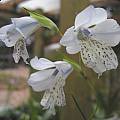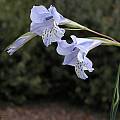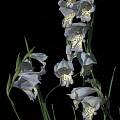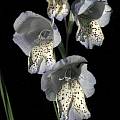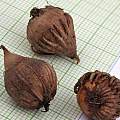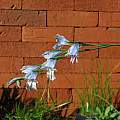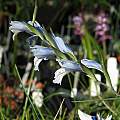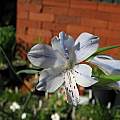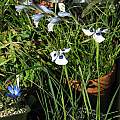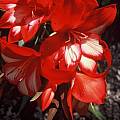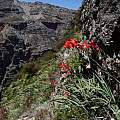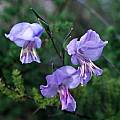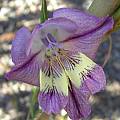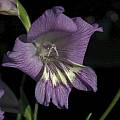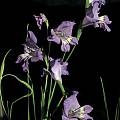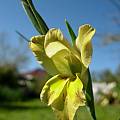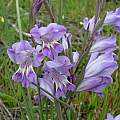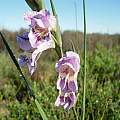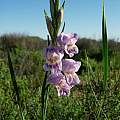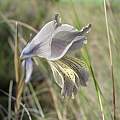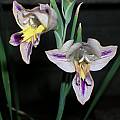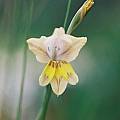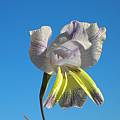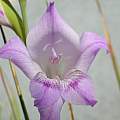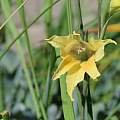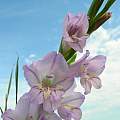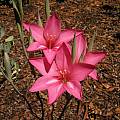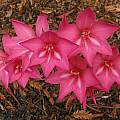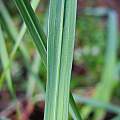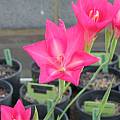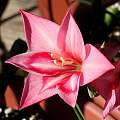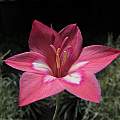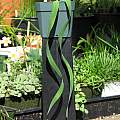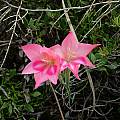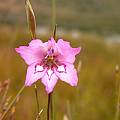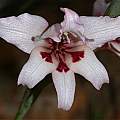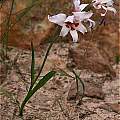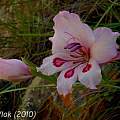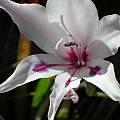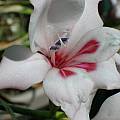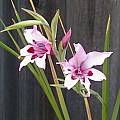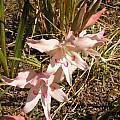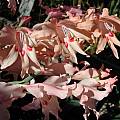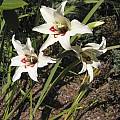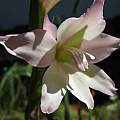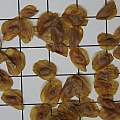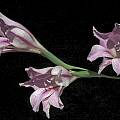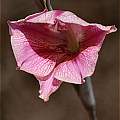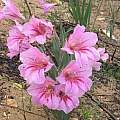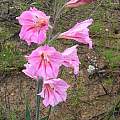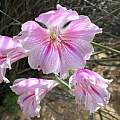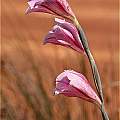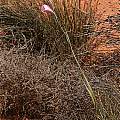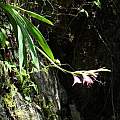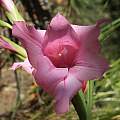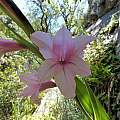There are about 163 species of Gladiolus (with new ones being discovered) in the area south of the Tropic of Capricorn and including Botswana, Lesotho, Namibia, South Africa, Swaziland, and Mozambique. Some are found in winter rainfall areas and some in summer rainfall areas. For more information see Goldblatt and Manning, 1998. Southern African species starting with Ca are pictured on this page.
Gladiolus index - Southern African Gladiolus A-B - Southern African Gladiolus Ce-E - Southern African Gladiolus F-H - Southern African Gladiolus I-Me - Southern African Gladiolus Mi-Pa - Southern African Gladiolus Pe-R - Southern African Gladiolus S-T - Southern African Gladiolus U-Z - Gladiolus Hybrids - Miscellaneous Gladiolus
Gladiolus caeruleus Goldblatt & J.C.Manning (syn. Gladiolus gracilis var. latifolia G.J.Lewis) is found on limestone outcrops and calcareous sands close to the coast in the Southwest Cape. The flowers are pale blue with dark speckles on the lower tepals. Plant height: 40-60 cm tall. It blooms in winter. Flower photos by Bob Rutemoeller, Mary Sue Ittner and Bob Werra. Corms from Telos Rare Bulbs by M. Gastil-Buhl on a 1 mm grid.
The photos below were taken by Nhu Nguyen of plants bought from Telos Rare Bulbs. The last photo shows a blue triad of this species with Moraea aristata and Tecophilaea cyanocrocus.
Gladiolus cardinalis Curtis grows on wet cliffs and waterfalls in the southwestern Cape area of South Africa where the corms are wedged into cracks in the rocks where they are protected. Corms and roots must be constantly wet. This species flowers in the driest time of the year in midsummer (mid December to mid January), and is pollinated by the mountain pride butterfly. It is often found growing together with Disa uniflora, an orchid pollinated by the same butterfly. Growing from 55 to 90 cm tall, it has bright red flowers with white spear-shaped marks. This very beautiful species was one of the parents of modern day hybrids. The first photo was taken by Rod Saunders. The second photo from Rachel Saunders was taken January 2013 where it grows in a waterfall that plunges down the side of the mountain off a cliff that is probably 500 m high.
Gladiolus carinatus Aiton is found on sandstone slopes or deep coastal sands in many areas of the Cape. It flowers late winter to spring and can be blue to violet or yellow, rarely pink, often with yellow markings on the lower tepals. Height range: 30-60 cm high. The first two photos were taken by Mary Sue Ittner; the first photo was taken September 2001 in the Southwest Cape and the second shows the flower of a plant grown from seed and flowering March 2004. The next two were taken by Bob Werra. The last photo from Cameron McMaster shows a yellow form grown from seed by Rhoda McMaster.
The first five photos were taken in the Western Cape in Hopefield, Elands Bay, and near Napier by Cameron McMaster. The last photo is from Rod Saunders.
The photos from Alan Horstmann show different forms.
Gladiolus carmineus C.H.Wright is a narrow endemic of the southwestern Cape coast (winter rainfall) where it grows on rocky sandstone cliffs within the sight of the sea. Flowers appear in the fall (mid February to April) and are pale to deep pink. Each of the lower three tepals and sometimes the upper lateral tepals have a median whitish streak surrounded by a pale mauve halo. There are three to five reduced leaves on the flowering stem. Foliage leaves produced by plants that did not flower appear later and are long and trailing, 8 to 10 mm wide, glaucous with a lightly thickened midrib. Height range: 30-50 cm. They grow during the wet winter and spring, drying off in late spring.
Some PBS members report that they get better results from this bulb in pots if watering is started in late summer (August in California). Others report that it blooms reliably in dry ground even if given no supplemental water. You may need to experiment to see what works best in your climate. It is definitely easier to grow in coastal climates. It has naturalized in the coastal Northern California garden of Bob Rutemoeller and Mary Sue Ittner. They scatter seeds about after the pods split open. The first four photos were taken in this garden. The third shows the long narrow foliage leaves of a clump in February 2014. The fourth is a closer view of a leaf. Mary Sue was asked why these leaves look different from the ones in Nhu's photo below. She did a tour of her garden and found leaves of different widths, some curled, some upright, and some flat. So it may depend on how and where the plants are growing, as well as how old they are. Photo 5 was taken in September, 2005 by David Victor, which flowers in the UK during September, followed later by the foliage. Flower stems and foliage are grey-green. David's plants hold typically four or five flowers on a spike. The last photo is from the summer hemisphere and was taken by Bill Dijk.
Photo 1 is of a slightly lighter-colored form grown by Michael Mace. Photos 2-3 were taken by Nhu Nguyen. Photo 3 shows the pendent habit of the leaves, which makes sense since it grows on cliffs.
Photos taken in habitat near Hermanus, South Africa by Cameron McMaster.
Gladiolus carneus F.Delaroche (syn. G. blandus Aiton ) has a wide distribution in the winter rainfall area of southern Africa and is found in a variety of habitats. It is a variable species that grows to about 50 cm with white to pink large flowers usually with dark spade shaped markings on the three lower lobes. It flowers late spring. This one seeds set very easily and also increases by cormlets. Photos taken in the wild, the first by Cameron McMaster in the Overberg and photos two and three by Andrew Harvie in Table Mountain National Park. Photo four is from the book Plants of the Klein Karoo courtesy of Jan and Anne Lise Schutte-Vlok. The last two photos are close-ups taken by Alan Horstmann.
The first photo was taken by Doug Westfall. The second one was taken June 2003 in Northern California of plants grown from seed, photo by Mary Sue Ittner. The third photo was taken by Jana Ulmer of plants grown from the same seed batch as the picture above. In 2004 both her population and Mary Sue's produced a lot of flowers that bloomed a very long time. Another form has been a reliable bloomer in our Northern California garden where it is planted in the ground and returns each year. Photo four by Bob Rutemoeller. Fifth photo is of an unmarked form, by Gordon Summerfield. Photo of seed on a 10 mm grid by David Pilling
Gladiolus caryophyllaceus (Burm.f.) Poir. grows on sandstone flats and slopes in the winter rainfall area, flowers winter to spring, and has large pink to mauve flowers that are speckled on the lower tepals and fragrant. Height range: 25-110 cm. This species has naturalized in Western Australia. The first four photos by Mary Sue Ittner, Bob Werra, and Alan Horstmann.
The first four habitat shots from Alan Horstmann were taken in the Western Cape. The last two habitat shots by Andrew Harvie were taken east of Koebeeberge in the Western Cape.
Gladiolus cataractarum is a rare endemic of the southern African summer rainfall region. Plants grow on cliffs and steep rocky slopes on quartzite in sheltered, south facing sites. Growing to 70 cm high, this species has eight to nine lanceolate leaves of different sizes and pink unscented flowers with the lower three tepals marked with reddish longitudinal lines. The first photo of the plant in habitat taken by Rod Saunders. Flower photos from Rachel Saunders. They had to walk up a gully to reach it and found it difficult to photograph hanging off the cliff.
Gladiolus index - Southern African Gladiolus A-B - Southern African Gladiolus Ce-E - Southern African Gladiolus F-H - Southern African Gladiolus I-Me -- Southern African Gladiolus Mi-Pa - Southern African Gladiolus Pe-R - Southern African Gladiolus S-T - Southern African Gladiolus U-Z - Gladiolus Hybrids - Miscellaneous Gladiolus
